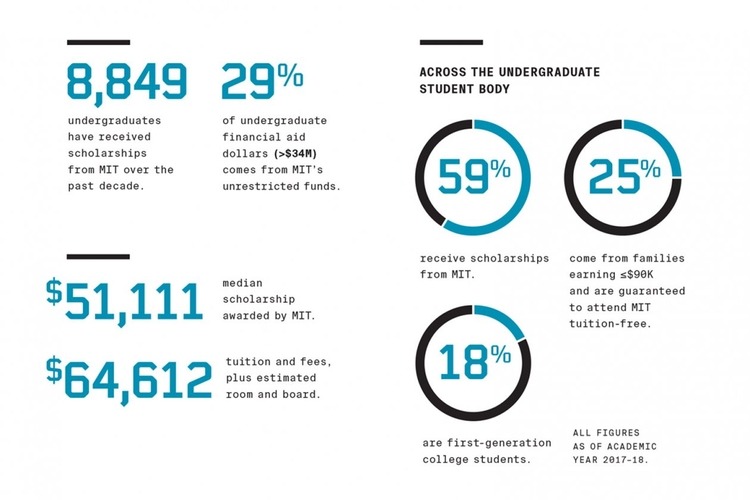“Now My Future Looks Very Different"
-
-
MIT Spectrum
Filed Under
Recommended

James Li ’19 remembers Pi Day 2015—the March 14 release of MIT admissions decisions. Steeling himself for disappointment, he shut himself into his bedroom to log on and learn his fate. The moment remains vivid in his mind. “I read the words. I couldn’t believe it. Read them over again. I walked across the room to my bed and just lay there face down for a bit. I didn’t think that would happen. And now my future looks very different than I thought it would.”
Born in China and raised in California, Li says he nearly didn’t apply to MIT, which “seemed like a whole other world, something kind of mythical.” There was another consideration: “I don’t think I would have applied had MIT not had need-based financial aid. Even if I got in, I wouldn’t have been able to go. Knowing it would be financially possible was definitely a factor in applying, and in accepting.”
For Li’s fellow senior, Kalyn Bowen ’19, MIT was a goal she was determined to pursue. “All of my friends ended up at the University of Hawaii, but if I had stayed in Hawaii, I feel like I would never have left. MIT was where I really wanted to be.” She adds: “If I didn’t get a scholarship and had to take out loans, I think I still would have come, but I would have been so stressed.” A first-generation college student who emigrated from Japan as a teen, she says p-sets provided ample stress as she struggled to catch up with classmates who’d had access to more AP classes and other advanced academic opportunities in high school. During a tough first year, she was “relieved that financial burden wasn’t a factor.”
I don’t think I would have applied had MIT not had need-based financial aid. Even if I got in, I wouldn’t have been able to go. Knowing it would be financially possible was definitely a factor in applying, and in accepting.
Neither Bowen nor Li have a single person to thank for the scholarships they received. Instead, each has a whole group of supporters. They are supported by funds established, respectively, by the Classes of 1979 and 1989. Hundreds of alumni have donated to funds like these, often to mark their reunion years, giving a collective boost to undergraduates for whom need-blind admissions paired with guaranteed need-based financial aid puts MIT in reach.
Bowen still has academic stress in her life, she says—but now she also has what she calls a happiness journal. “Every day for two years now, right before going to sleep, I write at least one happy thing that happened to me that day. There hasn’t been a day at MIT when I couldn’t think of a happy thing. It’s usually more than one thing. It’s usually like a five-bullet list.”
The richness of the MIT experience has led Li and Bowen, both set to graduate this spring, in unanticipated directions. Li’s major is mechanical engineering, but sampling classes across disciplines has shaped his aspirations as have hands-on research experiences at the MIT Media Lab’s City Science group, a robotics startup, and an R&D division at Ford. “My hope is to do something at the intersection of transportation, mechanical engineering, and urban planning,” he says. After discovering the Department of Anthropology, he has also gained an interest in how culture and technology interact. “I’d like to end up in a role where I can use my engineering skills to build something meaningful, but also think about how people use it and react to it, how it will affect communities.”
Bowen’s own arc has shifted since her first year. A computer science major with a love for learning languages, by junior year she found herself looking for ways to incorporate her growing passion for education. She interned at companies building apps for tutoring and for teaching children with no English language background how to code; assisted with intro classes in her department; and worked at a nonprofit supporting students from low-income backgrounds. “Teachers are some of the people I admire and appreciate the most. They’re the reason I’m here at MIT today,” she says. “I feel like they should be paid more and get more recognition. I started thinking about how I can change that. Majoring in computer science taught me math and logic I would need in any career, but after I graduate I’m planning on getting a master’s in political science and then going to law school so that I can become an educational lawyer.”
This article was excerpted from “To Be Continued,” part of a series on those who give and receive student and faculty support in the Winter 2019 issue of MIT Spectrum magazine.
Photo of Bowen and Li: Sarah Bastille
Coming this Pi Day, March 14: The classes of 1979 and 1989 are just two of the ten classes that—as they prepare to celebrate their reunion years—will participate in microchallenges to unlock bonus gifts during the third annual MIT 24-Hour Challenge. Join us, and collaborate with MIT alumni, students, parents, and friends to fuel the future at MIT. If 6,283 MIT alumni, students, parents, and friends give to MIT on March 14, 2019, an anonymous challenger will give the Institute $314,159, fueling the future at MIT and around the world.

Credit: MIT Spectrum







